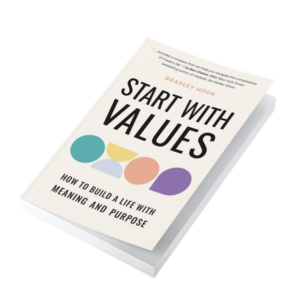Human values provide a powerful mechanism for decision-making. When we align with our values, life seems to flow. When there is misalignment, things can start to feel difficult
If I value health, then why is it so hard to exercise? If I value family, then why do I look at my phone while at the dinner table?
Humans are complex. An essential survival process is homeostasis, defined as “the tendency towards a relatively stable equilibrium between interdependent elements.”
Throughout our lives, we move away from pain and suffering and towards pleasure or comfort by activating a homeostatic response. If I’m in a hot room, I open the window to restore balance. If I’m thirsty, my body triggers emotions that guide me toward a water source.
However, homeostasis is a short-term thinker. It doesn’t plan or strategize. Even if vitality is a core value, we may experience resistance when we contemplate going for a run. The run is going to feel bad at first. Even just thinking about putting on shorts and braving the cold is enough to lure us toward the relative comfort of inaction. In this situation, homeostasis has done its job, protecting us from instability. But the long-term benefits of the run far outweigh short-term comfort or pleasure. We know this very well.
Engage values to drive action
To counter our default responses to challenging situations, we need to enable our core values to make decisions for us. Don’t leave it to homeostasis, chance, or the reptilian brain, which tends towards freeze, fight and flight. For coherent action, we need a decision-making framework that represents our core – our essence, if you like. Let’s revisit the running example. It is cold outside, and I’ve scheduled a run. All kinds of resistance and excuses start popping up. If I start with the value, i.e., vitality, I can unravel the method or action quite naturally after that.
It is a case of using the value to override automatic nervous system response. This enables us to design our behaviors rather than the behaviors designing us. Autopilot behavior gets us nowhere. We love examples of superhuman endurance and achieving the impossible. Take David Goggins, for example. It’s easy to assume that he was born a superman or that he just has a talent for fitness. This is not the case. He says in his videos that he doesn’t like exercising every day. He doesn’t exercise to feel great. He exercises rain or shine, no matter how much resistance there he feels because he values grit. The outcome is that he is the fittest man alive – but that was never the goal.
Values drive action. Action gets results. Coherent, values-aligned action is the ultimate success accelerant. You’re out there in the world, making an impact on your terms.
Conflicting values
Sometimes the resistance we often feel toward tasks or objectives comes from conflicting values. For example, I might value job security and family time. However, my job is demanding and places me under high levels of pressure. I’m working late and not seeing my kids. My well-being starts to deteriorate. I feel stressed and overwhelmed. Perhaps I begin to resent my work. This is classic values conflict.
Does this mean I need to get a new job or make sweeping changes? Will I need to start saying no? Can values conflicts be resolved?
Yes, to all of the above. Conflicting values can become a source of significant suffering. Imagine if I value healthy living but could only find a job within a fast-food chain. Or if I value both spirituality and family, yet my spouse does not value spirituality and asks me to stop meditating. The variables are infinite.
The key is to identify two kinds of values: means values and end values. Means values are usually malleable, and they change with time. They are how we get somewhere. End values are typically fixed and represent our essence. Of course, we can rediscover our values at any time. People often do after a traumatic event or health scare.
A means value is generating wealth. I might admire the values of the world’s richest people and genuinely believe that wealth will deliver me to my desired end state, which is a comfortable future, time freedom, and optimal well-being. The result of aligning with this value, if all goes well, will be early retirement, a beach house, and a healthy family.
However, in the short term, my pursuit of wealth is impacting both my health and relationships. Now, I need to dynamically apply the lenses of my core values to the challenge at hand.
- Can I embrace the current workload through the lens of wealth generation? This is going to be worth it. This is what is most important, and my future self will thank me for my efforts.
- Would I prefer to slow things down and apply my family lens? My future self will thank me for my self-awareness, and I’ll never regret the additional time spent with loved ones.
Decisions like this require a hierarchy of values. Once values are defined, we need to order them based on importance. It is worth identifying which are means values and which pertain to an end goal or state. A clear hierarchy will reduce ambiguity and enable intensely focused work. Suffering comes when we are neither immersed in an activity nor making clear decisions. We’re awash in the sea of other people’s dreams and desires.

Making group decisions based on values
Clearly defined group values enable individuals to confidently and autonomously make important decisions that affect the collective. This is essential for high-performing teams and those working in volatile environments where agility is paramount, and processes or workflows are not clearly defined. Having a clear purpose or mission is not always enough. It is through values that we can evaluate and execute the best possible action in uncertain and unprecedented situations.
For example, I could be a member of a special forces military unit. Our mission is to secure a building deep in enemy territory. We devise a detailed plan and brief all individuals. In the chaos of a battlefield, unimaginable variables create situations we could never have envisaged. Let’s say we’ve made it to the target building, but one of our team members is injured and unable to proceed. Do we continue and succeed in our mission, or do we turn back and rescue our team member? This is where values emerge. If our values are teamwork, honor, and courage, then we use these as our lens for action. We never leave a brother or sister behind. The mission may fail, but we’re all alive.
An alternative ending might be that we split the team and dedicate half the resources to rescue and half to mission success. Or if we value victory (at any cost), then we leave the soldier behind. Perhaps that is what they would want if they value honor and courage. This is a common narrative in many military films, where a fallen hero is left behind.
Values enable us to make human decisions. Decisions that we’ll be proud of or that we will regret.
Practice group decision making
Once collective values have been defined, it is critical to practice values-based decision-making in a safe environment. To do this, we simulate situations and ask participants to act based on core values. Be sure to throw in some conflicting values and discuss the value hierarchy. Remember, the perceived hierarchy might be different depending on which team you are in.
Let’s imagine a company where the values are: innovation, growth mindset, and customer service. The R&D team is more likely to value innovation, whereas the sales team will value customer service. Growth mindset serves everyone. Now, say an important product development milestone is scheduled for next Friday, but a key customer is experiencing technical issues with an existing product.
How do we allocate engineering resources? We use our hierarchical values to make the call. If innovation is #1, then we all agree that the existing client can wait. Everything else is secondary. See how much friction we’ve just eliminated? Everyone gets to sleep better at night except, of course, the customer with technical problems. However, at least we’re clear about our priorities. It may eventually serve this organization to adopt a different value if the conflict between innovation and service continues to arise. They may decide that innovation is their only concern and is so critical to our sustainability that we can afford to be sloppy with customers. Customer service might be replaced by camaraderie or some other value that bolsters internal cohesion.
The point is, being clear about values reduces friction. It empowers swift action with minimal ambiguity. This is the power of values-based decision-making.


